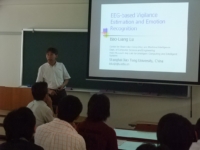| Summary: EEG, the signal directly recorded from the brain, can be used to reveal many states of the brain. The most usual state of the brain is the vigilance, which is the state of paying close and continuous attention. Vigilance affects human beings' performance significantly, which is crucial for drivers or others who needs high alertness. In our experiments, subjects are asked to drive a car on a long and boring road in a simulation system. We record both EEG signals and facial expressions during the subjects losing their vigilance. The spectrum powers extracted from the signals are used as the features. Then we apply clustering methods to estimate different vigilance states. The clustering results consist with the experts' judgments on the facial expressions. Another common kind of brain state in daily life is emotion. To elicit emotions, we show two kinds of pictures containing either smiling or crying human faces to the subjects. We use the gamma band activities extracted from the recorded EEG signals as the classification features. Then classification method is used to classify whether the subjects are happy or sad at that moment. We obtained an average of 93% classification accuracy across 10 subjects. |









